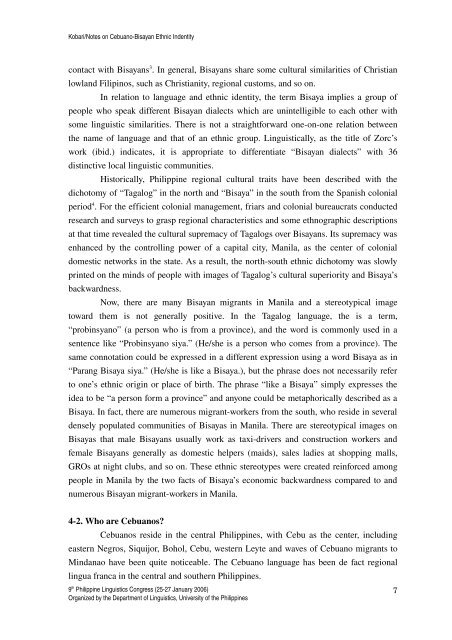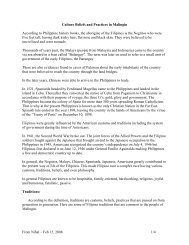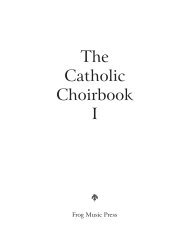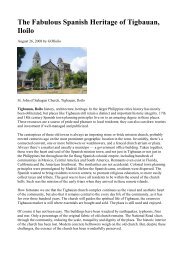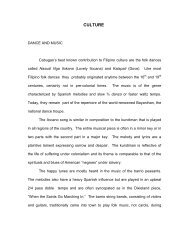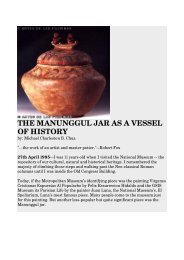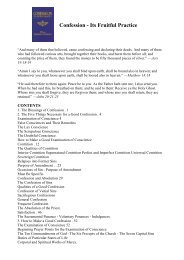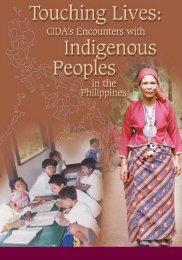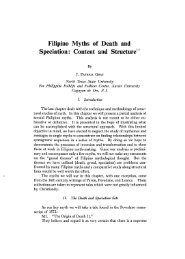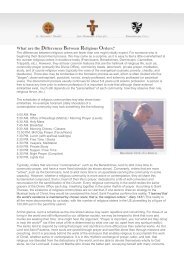Notes on Cebuano-Bisayan Ethnic Identity in the ... - AboutPhilippines
Notes on Cebuano-Bisayan Ethnic Identity in the ... - AboutPhilippines
Notes on Cebuano-Bisayan Ethnic Identity in the ... - AboutPhilippines
Create successful ePaper yourself
Turn your PDF publications into a flip-book with our unique Google optimized e-Paper software.
Kobari/<str<strong>on</strong>g>Notes</str<strong>on</strong>g> <strong>on</strong> <strong>Cebuano</strong><strong>Bisayan</strong> <strong>Ethnic</strong> Indentity<br />
c<strong>on</strong>tact with <strong>Bisayan</strong>s 3 . In general, <strong>Bisayan</strong>s share some cultural similarities of Christian<br />
lowland Filip<strong>in</strong>os, such as Christianity, regi<strong>on</strong>al customs, and so <strong>on</strong>.<br />
In relati<strong>on</strong> to language and ethnic identity, <strong>the</strong> term Bisaya implies a group of<br />
people who speak different <strong>Bisayan</strong> dialects which are un<strong>in</strong>telligible to each o<strong>the</strong>r with<br />
some l<strong>in</strong>guistic similarities. There is not a straightforward <strong>on</strong>e<strong>on</strong><strong>on</strong>e relati<strong>on</strong> between<br />
<strong>the</strong> name of language and that of an ethnic group. L<strong>in</strong>guistically, as <strong>the</strong> title of Zorc’s<br />
work (ibid.) <strong>in</strong>dicates, it is appropriate to differentiate “<strong>Bisayan</strong> dialects” with 36<br />
dist<strong>in</strong>ctive local l<strong>in</strong>guistic communities.<br />
Historically, Philipp<strong>in</strong>e regi<strong>on</strong>al cultural traits have been described with <strong>the</strong><br />
dichotomy of “Tagalog” <strong>in</strong> <strong>the</strong> north and “Bisaya” <strong>in</strong> <strong>the</strong> south from <strong>the</strong> Spanish col<strong>on</strong>ial<br />
period 4 . For <strong>the</strong> efficient col<strong>on</strong>ial management, friars and col<strong>on</strong>ial bureaucrats c<strong>on</strong>ducted<br />
research and surveys to grasp regi<strong>on</strong>al characteristics and some ethnographic descripti<strong>on</strong>s<br />
at that time revealed <strong>the</strong> cultural supremacy of Tagalogs over <strong>Bisayan</strong>s. Its supremacy was<br />
enhanced by <strong>the</strong> c<strong>on</strong>troll<strong>in</strong>g power of a capital city, Manila, as <strong>the</strong> center of col<strong>on</strong>ial<br />
domestic networks <strong>in</strong> <strong>the</strong> state. As a result, <strong>the</strong> northsouth ethnic dichotomy was slowly<br />
pr<strong>in</strong>ted <strong>on</strong> <strong>the</strong> m<strong>in</strong>ds of people with images of Tagalog’s cultural superiority and Bisaya’s<br />
backwardness.<br />
Now, <strong>the</strong>re are many <strong>Bisayan</strong> migrants <strong>in</strong> Manila and a stereotypical image<br />
toward <strong>the</strong>m is not generally positive. In <strong>the</strong> Tagalog language, <strong>the</strong> is a term,<br />
“prob<strong>in</strong>syano” (a pers<strong>on</strong> who is from a prov<strong>in</strong>ce), and <strong>the</strong> word is comm<strong>on</strong>ly used <strong>in</strong> a<br />
sentence like “Prob<strong>in</strong>syano siya.” (He/she is a pers<strong>on</strong> who comes from a prov<strong>in</strong>ce). The<br />
same c<strong>on</strong>notati<strong>on</strong> could be expressed <strong>in</strong> a different expressi<strong>on</strong> us<strong>in</strong>g a word Bisaya as <strong>in</strong><br />
“Parang Bisaya siya.” (He/she is like a Bisaya.), but <strong>the</strong> phrase does not necessarily refer<br />
to <strong>on</strong>e’s ethnic orig<strong>in</strong> or place of birth. The phrase “like a Bisaya” simply expresses <strong>the</strong><br />
idea to be “a pers<strong>on</strong> form a prov<strong>in</strong>ce” and any<strong>on</strong>e could be metaphorically described as a<br />
Bisaya. In fact, <strong>the</strong>re are numerous migrantworkers from <strong>the</strong> south, who reside <strong>in</strong> several<br />
densely populated communities of Bisayas <strong>in</strong> Manila. There are stereotypical images <strong>on</strong><br />
Bisayas that male <strong>Bisayan</strong>s usually work as taxidrivers and c<strong>on</strong>structi<strong>on</strong> workers and<br />
female <strong>Bisayan</strong>s generally as domestic helpers (maids), sales ladies at shopp<strong>in</strong>g malls,<br />
GROs at night clubs, and so <strong>on</strong>. These ethnic stereotypes were created re<strong>in</strong>forced am<strong>on</strong>g<br />
people <strong>in</strong> Manila by <strong>the</strong> two facts of Bisaya’s ec<strong>on</strong>omic backwardness compared to and<br />
numerous <strong>Bisayan</strong> migrantworkers <strong>in</strong> Manila.<br />
42. Who are <strong>Cebuano</strong>s?<br />
<strong>Cebuano</strong>s reside <strong>in</strong> <strong>the</strong> central Philipp<strong>in</strong>es, with Cebu as <strong>the</strong> center, <strong>in</strong>clud<strong>in</strong>g<br />
eastern Negros, Siquijor, Bohol, Cebu, western Leyte and waves of <strong>Cebuano</strong> migrants to<br />
M<strong>in</strong>danao have been quite noticeable. The <strong>Cebuano</strong> language has been de fact regi<strong>on</strong>al<br />
l<strong>in</strong>gua franca <strong>in</strong> <strong>the</strong> central and sou<strong>the</strong>rn Philipp<strong>in</strong>es.<br />
9 th Philipp<strong>in</strong>e L<strong>in</strong>guistics C<strong>on</strong>gress (2527 January 2006)<br />
Organized by <strong>the</strong> Department of L<strong>in</strong>guistics, University of <strong>the</strong> Philipp<strong>in</strong>es<br />
7


